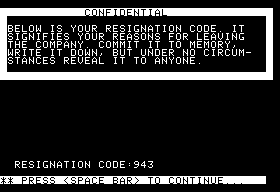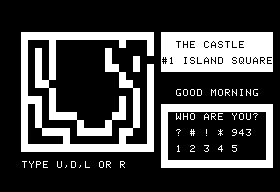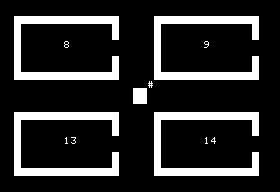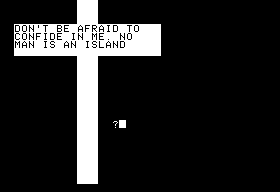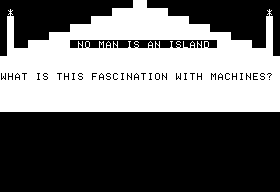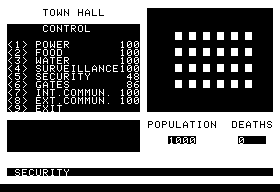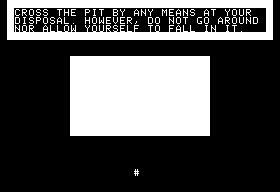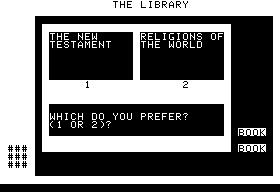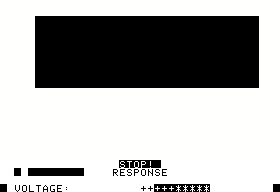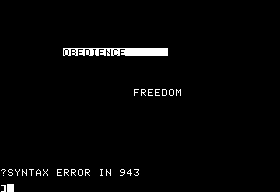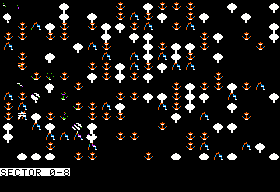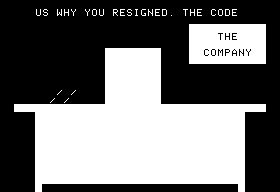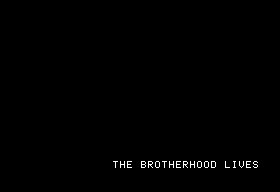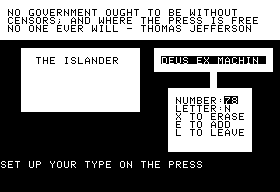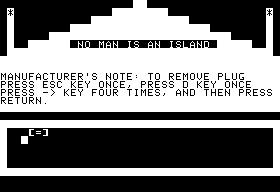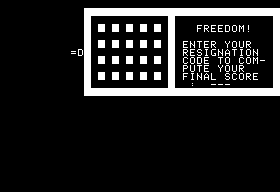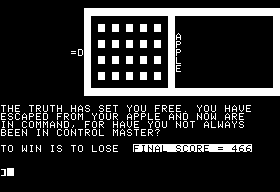Just to demonstrate how thoroughly rotten my commercial instincts are, for my first post after returning from my little holiday hiatus I’m going to go all meta and esoteric on you and talk about a truly burning question: the exact dates of events in Richard Garriott’s early career as a game designer. I have a couple of reasons for picking these particular nits. The first and most self-interested is that I’m about to begin looking at old Richard, whom you might better know as Lord British, as my next big subject for discussion, and I want to preemptively defend myself against hordes of Ultima fans taking issue with my dating of events. The other is that this little tale may serve as an example of the process I go through to come to (my version of) historical truth, as well as the advantages and drawbacks of different sorts of sources. If you’re an historian, a reporter, or a researcher, you’re likely all too familiar with trying to reconcile separate pieces of credible evidence that nevertheless contradict each other. If you’re not, though, maybe you’ll be interested to know just what a digital antiquarian has to go through these days.
Garriott’s life and career has been better documented than that of all but a handful of game designers. In addition to countless magazine and Internet profiles, much of the book Dungeons and Dreamers was devoted to him, and the various editions of Shay Addams’s The Official Book of Ultima all fawned over him and his history with abandon. Given that, I was surprised to find myself so uncertain about the dating of Garriott’s first game, Akalabeth.
The story of Akalabeth has been told many times; if you haven’t heard it yet, stay tuned for my next post, wherein I’ll get back to historical narrative and tell you all about it. For now, though, the short version is that Garriott wrote it on his Apple II in the summer of 1979, while he was working at an Austin, Texas, ComputerLand store between high school (which he’d finished that spring) and starting at the University of Texas. His boss saw the game and suggested that he package it and sell it in the store, which Garriott did. Within days a copy had made its way — probably through the magic of piracy — to California Pacific, a major early software publisher. They flew young Richard out to California to sign him to a distribution deal, and Akalabeth became a huge hit, selling 30,000 copies and netting Garriot some $150,000 — not a bad nest egg for a kid to carry off to college. This is the story told in both of the books I mentioned above, and the one that Garriott has repeated in interviews stretching back literally decades. As the guy at the center of all these events, Garrott certainly ought to know. Yet when we start to dig into some primary sources the waters quickly muddy.
By far the best way I know to track the month-by-month doings of the early computer industry is via the magazines. In them we can watch as products are introduced and trends come and go, all with hard dates indelibly stamped right there on the covers. Sometimes, as in this case, the things we find there can upset chronologies that have come to be accepted as unchallenged fact.
Softalk magazine is one of the best resources on the early Apple II market. Surprisingly, Akalabeth does not appear there until the January, 1981, issue. Once it does, however, it appears in a big way, with a prominent mention in an article on California Pacific, a feature review, a listing at position 23 in Softalk‘s list of the top 30 Apple II software bestsellers, and the inauguration of a contest to deduce the real identity of Akalabeth creator Lord British (i.e., Garriott). Allowing for the typical magazine lead time of a couple of months, everything would seem to indicate that Akalabeth was in late 1980 a brand new product (at least on the national stage), more than a year after the standard narrative says Garriott wrote it. If we accept that, we are left with two possibilities, both of which to some extent contradict Garriott’s story. Either Akalabeth was not in fact picked up by California Pacific until more than a year after its creation, languishing in that time in obscurity while Garriott did the college thing, or it was not created in the summer of 1979, after his senior year in high school, but rather in the summer of 1980, after his freshman year at university. Howard Feldman recently scanned a copy of an original ComputerLand Akalabeth for his superb Museum of Computer Adventure Game History. That edition bears a copyright of 1980, which leaves me pretty confident that the latter scenario is in fact the correct one; Garriott himself as well as the conventional histories are off by fully one year. Further, I also find myself doubting Garriott’s sales claims. An article in the September/October, 1982, issue of Computer Gaming World tells us that The Wizard and the Princess, a game that was a Softalk top 10 perennial throughout late 1980 and 1981, had by mid-1982 sold just 25,000 copies. It’s hard to imagine how Akalabeth, which sneaked into the bottom parts of the top 30 only a few times during that period, could have ended up with the sales figures claimed.
Which of course leaves me wondering why Garriott has for so many years been saying things I’m almost certain are not true. While anyone who went around calling himself “Lord British” without a trace of apparent irony is maybe not quite the self-effacing sort, I’ve never seen anything to indicate that Garriott is dishonest. Indeed, in every interview I’ve seen he seems very level-headed and trustworthy. And it’s hard to see a reason why he might choose to knowingly falsify his dates. If having Akalabeth out in 1979 rather than 1980 maybe makes him seem slightly more of a pioneer, Garriott’s real record of accomplishments is certainly strong enough that it needs no boosting. Nor does an earlier release date give him a claim to any additional firsts; a 1979 Akabaleth is still far from the first CRPG, and his game is still not even all that impressive against the likes of Temple of Apshai, a much more ambitious and sophisticated piece of software already released by that summer of 1979. And as for sales… well, Garriott’s later games would sell in such quantities that he hardly needed to inflate the numbers for Akalabeth to assert his claim to importance.
So, no, I don’t believe that Garriott is knowingly lying to us. I do believe, however, that the human memory is a tricky thing. Much as the current fad for all things neuroscience annoys me, I found this episode of Radiolab about the workings of memory pretty fascinating. It describes remembering as an act of imaginative recreation rather than a mere retrieval from storage, and makes the counter-intuitive claim that the more we remember something, the more we dwell on it, the more distorted and inaccurate it can become. That’s one reason I’m very sparing in my use of direct interviews (another reason of course being that plenty of people have better things to do than talk with me anyway). It’s very easy for a person to start to believe his legend, whether it originated with his own early press releases or elsewhere, and to insert that version of events into his memory in lieu of reality. Ironically, I find that less heralded figures such as Lance Micklus often offer the most trustworthy recollections, as their versions of the past have not been distorted by years of repeating the same deeply engrained stories.
Anyway, this provides an example of the process I go through in trying to get to historical truth, balancing sources against one another and trying to reconstruct the most viable version of the past. The most frustrating cases are those for which I just can’t gather enough evidence, as in the case of the Eamon timeline, in which I had a creator who refuses to talk about his creation, a major figure (John Nelson) absolutely certain of one timeline of events, a single magazine article which would seem to imply another timeline but which doesn’t do so quite definitively, and otherwise a complete void of credible information. That’s when I have to just throw up my hands and admit I just don’t know — which is frustrating, because if I can’t document this stuff it may never get done.
Actually, that raises a good point: the “so what?” aspect of all this. In the end it’s maybe not of world-shaking importance to know whether one game designer released his first creation in 1979 or 1980, nor whether it sold 30,000 or 3000 copies. But in another way it’s important to me to get this stuff right, and not just because of the trite but true maxim that anything worth doing is worth doing right. Interactive entertainment looks certain to be the defining media of the 21st century, and therefore to be something eminently worth studying. Those who write about videogames have generally done the form few favors — just another aspect of a form of media that seems to have a hard time growing up and realizing its potential. Whatever you think of books of lists, I can’t help but compare the 1001 Movies You Must See Before You Die or 1001 Albums You Must Hear Before You Die books with 1001 Video Games You Must Play Before You Die. The former are thoughtful, filled with a defensible if not absolute canon of genuinely great films and music; the latter is a mishmash of titles apparently plucked out of thin air, with commentary that often reads like it was lifted straight from the box copy. I’m not at all sure there even are 1001 videogames you “must” play, but surely there’s been enough good work produced in the last 35 years or so that we can do it a little bit better justice. I don’t want this to turn into a rant on the state of game journalism, so I’ll just say that I think we can do a better job of chronicling this medium’s history, and that this blog is my humble contribution to that ambition.
In addition, it’s kind of exhilarating to dig through the past and turn up things you didn’t expect. That’s already happened a number of times for me in the months I’ve been researching this blog, as when I discovered that Scott Adams had written eight of his “classic dozen” adventures before the 1970s were even over, or that the TRS-80 sold so well in its first couple of years that it left all the other platforms (including the legendary Apple II) fighting over the tiny non-Radio Shack scrap of the PC market. Put another way: primary sources rule. And hey, if stuff like that doesn’t interest you you probably never made it through this post, much less this blog. Let’s wallow in trivia together, shall we?
